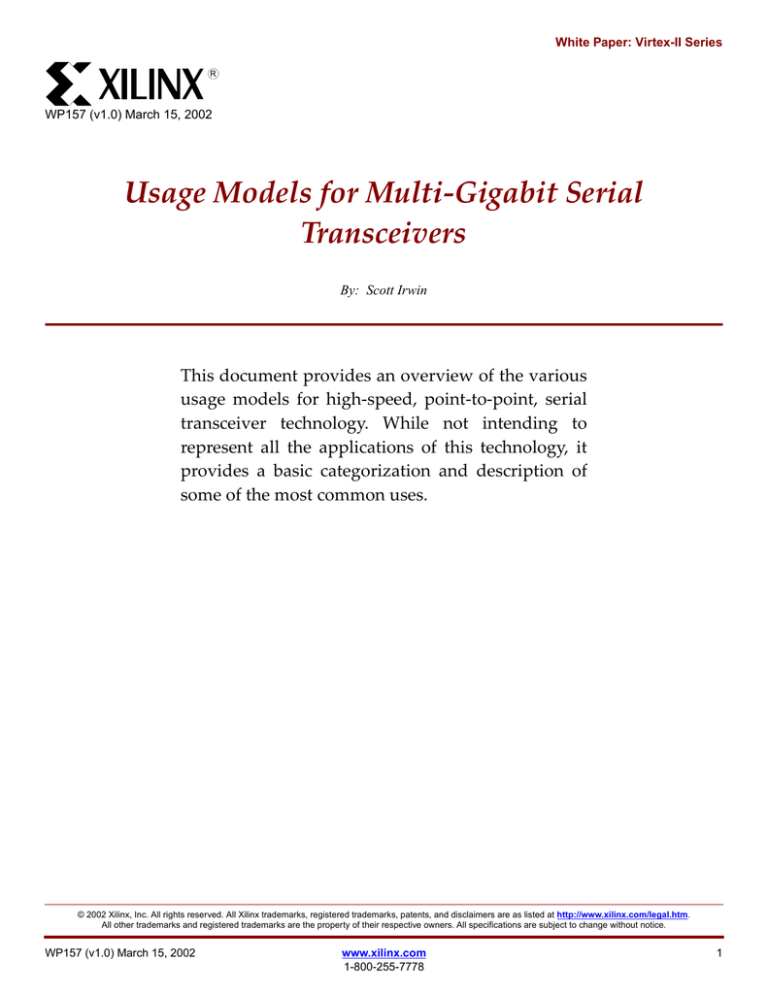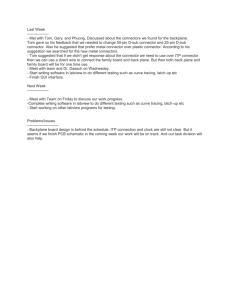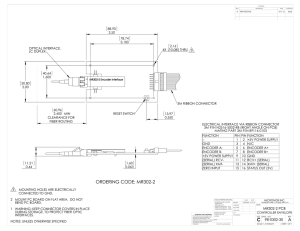
White Paper: Virtex-II Series
R
WP157 (v1.0) March 15, 2002
Usage Models for Multi-Gigabit Serial
Transceivers
By: Scott Irwin
This document provides an overview of the various
usage models for high-speed, point-to-point, serial
transceiver technology. While not intending to
represent all the applications of this technology, it
provides a basic categorization and description of
some of the most common uses.
© 2002 Xilinx, Inc. All rights reserved. All Xilinx trademarks, registered trademarks, patents, and disclaimers are as listed at http://www.xilinx.com/legal.htm.
All other trademarks and registered trademarks are the property of their respective owners. All specifications are subject to change without notice.
WP157 (v1.0) March 15, 2002
www.xilinx.com
1-800-255-7778
1
R
White Paper: Usage Models for Multi-Gigabit Serial Transceivers
Overview
To highlight the basic usage categories, a representative communications system is
shown in Figure 1. Within this system, communication takes place at various levels
and distances, including within a PCB or card, between PCBs within a chassis, and
between equipment or chassis. For the most part, these categories are based on the
distance to which each is targeted. The four basic categories discussed in detail in later
sections are as follows:
•
•
•
•
Chip-to-Chip
Backplane
Copper Cable
Optical Cable
Communications Equipment
Stacking /
Expansion Cable
Communications
Equipment
Isolation
Switch Card
Physical
Layer /
SERDES
Switch
Fabric
Interface
Switch Fabric
Copper Cable
O/E
Physical
Layer /
SERDES
Optical
Fiber
Link
Layer
E/O
Network
Proc. /
Traffic
Mgmt.
Switch
Fabric
Interface
Backplane
Line Card
Backplane
Chip-to-Chip
Optical Cable
Line Card
O/E
Physical
Layer /
SERDES
Optical
Fiber
Communications
Equipment
Link
Layer
E/O
Network
Proc. /
Traffic
Mgmt.
Switch
Fabric
Interface
WP157_01_030602
Figure 1:
Communications System Example
To successfully design and deploy products using multi-gigabit serial links, the
signaling channel must be carefully designed with the aid of high-accuracy simulation
and channel simulation models. Since each of these applications utilizes different
elements, the models should be appropriate to the environment and components
used. Many manufacturers provide models for their active and passive components.
Notes:
1. In the basic channel models described throughout this document, on-chip termination (as is
provided in the Rocket I/O serial interfaces of the Xilinx Virtex-II Pro™ FPGA family) is assumed as
part of the driver and receiver integrated circuits. If termination is done off chip, it must be
accounted for in the appropriate location in the signaling channel and model.
2
www.xilinx.com
1-800-255-7778
WP157 (v1.0) March 15, 2002
R
White Paper: Usage Models for Multi-Gigabit Serial Transceivers
Chip-to-Chip
Applications
A chip-to-chip application is the simplest and most basic application for high-speed,
serial transceivers. It can include single channel, multiple channel (independent), or
multiple channel (bonded) configurations. Only the IC package and printed circuit
board (PCB) elements are between the driver and receiver.
Some examples of high-speed serial interconnect standards supporting chip-to-chip
interfacing include the 10G Attachment Unit Interface (XAUI)[1], Serial Rapid I/O,
and 3GIO. Proprietary interfaces are also common, where maximum data rate and pin
limitations demand this level of performance.
A basic model for this medium includes the driver, driver termination, driver package,
PCB elements (traces, vias, etc.), receiver package, receiver termination, and receiver.
An example is illustrated in Figure 2.
TXP
Driver, TXN
Rcvr.
and
Term. RXP
RXP
IC
Package
RXN
PCB
IC
Package
RXN Driver,
Rcvr.
and
TXP Term.
TXN
WP157_02_022602
Figure 2:
Basic Channel Model for Chip-to-Chip Applications
XAUI
XAUI is defined in the 10G Ethernet standard[1] for extending the useful reach of the
XGMII interface between the link and physical layer. It consists of four channel
bonded 3.125 Gb/s interfaces with an aggregate bandwidth of 12.5 Gb/s (10 Gb/s
useful payload with 8B/10B encoding overhead). The standard defines chip-to-chip
connectivity up to 20" of FR4 PCB trace. XAUI can also be used in backplane
applications.
Backplane
Applications
A backplane application is similar to chip-to-chip, but adds at least one electrical
connector and additional PCB assemblies between the driver and receiver. Some
applications include daughter (or mezzanine) cards, chassis and switch fabrics. It can
include single channel, multiple channel (independent), or multiple channel (bonded)
configurations.
Some examples of high-speed serial interconnect standards supporting backplane
interfacing include XAUI[1], Serial RapidIO, InfiniBand[2], and 3GIO. Proprietary
interfaces are also common, where highest data rate with the fewest pins demand this
level of performance.
A generic model for the backplane medium includes the driver, driver termination,
driver package, at least one connector, PCB elements (traces, vias, etc.), receiver
package, receiver termination, and receiver. An example with two connectors and
backplane PCB is illustrated in Figure 3.
WP157 (v1.0) March 15, 2002
www.xilinx.com
1-800-255-7778
3
R
TXP
Driver, TXN
Rcvr.
and
Term. RXP
RXN
White Paper: Usage Models for Multi-Gigabit Serial Transceivers
IC
Package
PCB
Conn.
Backplane
PCB
Conn.
PCB
IC
Package
RXP
RXN Driver,
Rcvr.
and
TXP Term.
TXN
WP157_03_022602
Figure 3:
Basic Channel Model for Backplane Applications
XAUI
In addition to chip-to-chip applications, the XAUI can support communication to
mezzanine cards or across a backplane and up to a total 20 inches of FR4 PCB trace.
Two examples of high-speed connectors supporting XAUI (and other) backplane links
include the Teradyne VHDM-HSD™[3] and the Tyco/AMP Z-PACK
HM-Zd[4]. These are illustrated in Figure 4 and Figure 5, respectively. For more
information on these products, go to http://www.teradyne.com and
http://www.amp.com.
Figure 4:
Teradyne VHDM-HSD™ Backplane Connector
Figure 5: Tyco/AMP Z-PACK HM-Zd Backplane Connector
4
www.xilinx.com
1-800-255-7778
WP157 (v1.0) March 15, 2002
White Paper: Usage Models for Multi-Gigabit Serial Transceivers
R
InfiniBand
The backplane connector specified by the InfiniBand™ standard is shown in Figure 6.
It is based on the SpeedPac technology from Tyco/AMP and supports 1x, 4x, and 12x
serial channel configurations. The connector consists of a card edge “paddle” (with
paddle guard) and backplane socket combination.
Figure 6:
Copper Cable
Applications
(a) InfiniBand Backplane Connector and Board Paddle and
(b) Paddle Guard Assembly
Copper cabling can be used to interconnect system components over short to medium
distances (generally up to about 20m) at data rates up to about 3.125 Gb/s. These
cables are generally based upon shielded twisted pair (STP), coaxial, twin-axial, or
other similar technologies. Copper cabling has the advantage of utilizing familiar
electrical signaling technology rather than more exotic (and generally more expensive)
optical technology. There is a tradeoff between data rate and distance, with greater
distances coming at the expense of lower data rates. Some type of galvanic isolation
(blocking capacitors, transformers, etc.) is typically required. While single channel,
dual simplex configurations (single differential pair in each direction) are the most
common, multiple channel configurations can also be used.
Some examples of high-speed serial interconnect standards supporting copper cabling
include Fibre Channel[5], Gigabit Ethernet (1000Base-CX)[6], and InfiniBand[2].
A generic model for this medium typically includes the driver, driver termination,
driver package, electrical connector, cable, electrical connector, receiver package,
receiver termination, and receiver. Any PCB elements (traces, vias, etc.) and source or
destination isolation (caps, transformers, etc.) would also be included, where
appropriate. An example is illustrated in Figure 7.
WP157 (v1.0) March 15, 2002
www.xilinx.com
1-800-255-7778
5
R
TXP
Driver, TXN
Rcvr.
and
Term. RXP
RXN
White Paper: Usage Models for Multi-Gigabit Serial Transceivers
IC
Package
PCB
Cable
Conn.
Cable
Cable
Conn.
PCB
IC
Package
RXP
RXN Driver,
Rcvr.
and
TXP Term.
TXN
WP157_07_022602
Figure 7:
Basic Channel Model for Copper Cable Applications
InfiniBand
An example of a high-speed cabled solution can be found in the InfiniBand standard.
This standard supports communication at 2.5 Gb/s per differential signal pair over 1,
4, and 12 channels in each direction. Examples of the connector technology adopted
by this standard are shown in Figure 8 and Figure 9. The 1x connector is based upon
the HSSDC2 technology from Tyco/AMP[7]. More information on InfiniBand and the
copper cabling standard can be found in reference [2].
Figure 8: InfiniBand Connector Example (1x)
Figure 9:
6
InfiniBand Connector Examples (4x, 12x)
www.xilinx.com
1-800-255-7778
WP157 (v1.0) March 15, 2002
R
White Paper: Usage Models for Multi-Gigabit Serial Transceivers
Optical Cable
Applications
Optical cable solutions can provide the highest combination of data rate and
transmission distance. Solutions are now available over a wide range of
cost/performance tradeoffs, from very short reach, shortwave, multimode fiber to
long-haul, long-wave, single-mode fiber supporting distances of over 40 km. In
addition to single channel serial implementations, other options include aggregating
multiple channels via parallel optical ribbon cable or wave division multiplexing
(WDM).
Some examples of high-speed serial interconnect standards supporting optical cabling
include Fibre Channel[5], Gigabit Ethernet (1000Base-SX/LX)[6], 10 Gigabit Ethernet[1],
InfiniBand[2] and the OIF Very Short Reach (VSR) standards[8][9][10][11]. In addition,
there are several optical transceiver form-factor definitions available, including
Gigabit Interface Converter (GBIC), Small Form-Factor (SFF), Small Form-factor
Pluggable (SFP)[12], XENPAK[13], and XGP[14], to name a few. Paroli® and MPO are
common parallel optical ribbon cable and connector solutions.
A generic model for this medium typically includes the driver, driver termination,
driver package, electro-optical (E/O) converter, optical media (fiber, patch panels, and
connectors), electro-optical (O/E) converter, receiver package, receiver termination,
and receiver. Any PCB elements (traces, vias, etc.) and multi-channel optical
components (parallel fiber, WDM, etc.) would also be included, where appropriate.
An example is illustrated in Figure 10.
RXP
TXP
Driver, TXN
Rcvr.
and
Term. RXP
IC
Package
PCB
ElectroOptical
Device
Fiber,
Patch
Panels,
Conn.
ElectroOptical
Device
PCB
IC
Package
RXN
RXN Driver,
Rcvr.
and
TXP Term.
TXN
WP157_10_022602
Figure 10: Basic Channel Model for Optical Cable Applications
XENPAK
An example optical transceiver standard is the XENPAK Multi-Source Agreement
(MSA)[12]. These provide a pluggable form-factor with an SC Duplex optical
receptacle, as illustrated in Figure 11. These modules utilize the XAUI interface on the
system (electrical) side, while the external (optical) interface can be any of the various
line standards defined in 10 Gigabit Ethernet[1]. These include 10GBase-SR/W,
10GBase-LR/W, 10GBase-ER/W, and 10GBase-LX4.
WP157 (v1.0) March 15, 2002
www.xilinx.com
1-800-255-7778
7
R
White Paper: Usage Models for Multi-Gigabit Serial Transceivers
Figure 11:
XENPAK MSA Optical Module Assembly
InfiniBand
In addition to backplane and copper cable options, the InfiniBand standard supports
1x, 4x, and 12x optical interconnect options at 2.5 Gb/s per fiber. Although the optical
module form-factor is not specified, the connector technology is defined. The 1x
standard is based on an LC duplex connector, while the 4x and 12x standards utilize
the 12-fiber MPO connector, as illustrated in Figure 12. The fiber connections can be
seen as dark row of holes between the alignment holes on the cable and alignment
pins on the socket. The 4x channel requires 8 fibers (4 each direction), leaving 4 of the
12 channels unused. The 12x channel requires two such cables, each carrying 12 fibers
in each direction. See Figure 12.
Figure 12:
8
InfiniBand™ MPO Fiber Optic Connector (4x, 12x)
www.xilinx.com
1-800-255-7778
WP157 (v1.0) March 15, 2002
White Paper: Usage Models for Multi-Gigabit Serial Transceivers
R
Optical Internetworking Forum (OIF)
Several standards have been defined within the Optical Internetworking Forum (OIF)
to support Very Short Reach (VSR) optical communication channels. The following
four OIF implementation agreements support the OC-192 (~10 Gb/s) generation of
SONET equipment:
•
VSR4-01.0[8]: Aggregated link of 12 fibers operating at 1.244 Gb/s per fiber using
8b/10b encoding. Utilizes multi-mode, parallel optical ribbon cable with MTP™
(MPO) connector (each direction) and shortwave (850 nm) optoelectronics,
supporting distances up to 300m.
•
VSR4-02.0[9]: Single fiber operating at 9.953 Gb/s (OC-192). Utilizes single-mode
fiber and longwave (1310 nm) optoelectronics, supporting distances up to 600m.
•
VSR4-03.0[10]: Aggregated link of four fibers operating at 2.5 Gb/s per fiber.
Utilizes multi-mode, parallel optical ribbon cable with MTP (MPO) connector
(one 12 fiber ribbon with 4 fibers each direction and middle four unused) and
shortwave (850 nm) optoelectronics, supporting distances up to 300m.
•
VSR4-04.0[11]: Single fiber operating at 9.953 Gb/s (OC-192). Utilizes multi-mode
fiber and shortwave (850 nm) optoelectronics, supporting distances to 85m-300m.
References
1. IEEE P802.3ae/D3.2, Media Access Control (MAC) Parameters, Physical Layer,
and Management Parameters for 10 Gb/s Operation, August 15, 2001.
http://www.ieee.org
2. InfiniBand Architecture Specification Release 1.0.a, Volume 2 – Physical
Specification, InfiniBand Trade Association. June 19, 2001.
http://www.infinibandta.org
3. Teradyne Technical Bulletin TB-2084, The Teradyne VHDM® HSD
Interconnection System Electrical Characterization Report, April 4, 2001.
http://www.teradyne.com/prods/tcs
4. Tyco Electronics/AMP Catalog 1308658, Z-PACK HM-Zd Data Sheet, Mar 2001.
http://www.amp.com/communications/documents/1308658.pdf
5. ANSI X3.230-1994, Fibre Channel Physical and Signaling Interface (FC-PH) Rev
4.3, 1994. http://www.ansi.org
6. IEEE 802.3z-1998, Media Access Control (MAC) Parameters, Physical Layer,
Repeater, and Management Parameters for 1000Mb/s Operation, 1998.
http://www.ieee.org
7. Tyco Electronics/AMP Application Specification 114-13028, High Speed Serial
Data Connector 2 (HSSDC2), February 22, 2001.
http://catalog.tycoelectronics.com/TE/docs/pdf/1/79/219971.pdf
8. OIF VSR-4-01.0, Very Short Reach (VSR) OC-192/STM-64 Interface Based on
Parallel Optics, December 18, 2000. http://www.oiforum.com
9. OIF VSR-4-02.0, Serial OC-192 1310 nm Very Short Reach (VSR) Interfaces,
November 16, 2000. http://www.oiforum.com
10. OIF VSR-4-03.0, Very Short Reach (VSR) OC-192 four fiber Interface Based on
Parallel Optics, August 17, 2000. http://www.oiforum.com
WP157 (v1.0) March 15, 2002
www.xilinx.com
1-800-255-7778
9
R
White Paper: Usage Models for Multi-Gigabit Serial Transceivers
11. OIF VSR-4-04.0, Serial Shortwave Very Short Reach (VSR) OC-192 Interface for
Multimode Fiber, January 22, 2001. http://www.oiforum.com
12. Small Form-factor Pluggable (SFP) Transceiver Multi-Source Agreement (MSA),
September 14, 2000.
13. XENPAK MSA Rev 2.0, A Cooperation Agreement for 10 Gigabit Ethernet
Transceiver Package, September 26, 2001. http://www.xenpak.org/MSA.asp
14. http://www.xgpmsa.com
Revision
History
10
The following table shows the revision history for this document.
Date
Version
03/15/02
1.0
Revision
Initial Xilinx release.
www.xilinx.com
1-800-255-7778
WP157 (v1.0) March 15, 2002




